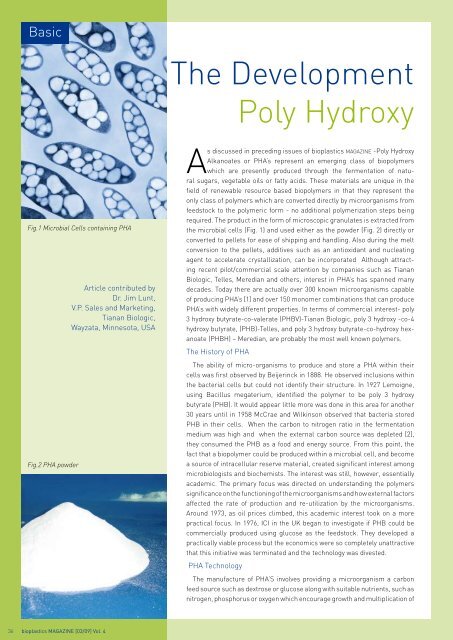bioplasticsMAGAZINE_0903
bioplasticsMAGAZINE_0903
bioplasticsMAGAZINE_0903
You also want an ePaper? Increase the reach of your titles
YUMPU automatically turns print PDFs into web optimized ePapers that Google loves.
Basic<br />
The Development<br />
Poly Hydroxy<br />
Fig.1 Microbial Cells containing PHA<br />
Fig.2 PHA powder<br />
Article contributed by<br />
Dr. Jim Lunt,<br />
V.P. Sales and Marketing,<br />
Tianan Biologic,<br />
Wayzata, Minnesota, USA<br />
As discussed in preceding issues of bioplastics MAGAZINE -Poly Hydroxy<br />
Alkanoates or PHA’s represent an emerging class of biopolymers<br />
which are presently produced through the fermentation of natural<br />
sugars, vegetable oils or fatty acids. These materials are unique in the<br />
field of renewable resource based biopolymers in that they represent the<br />
only class of polymers which are converted directly by microorganisms from<br />
feedstock to the polymeric form - no additional polymerization steps being<br />
required. The product in the form of microscopic granulates is extracted from<br />
the microbial cells (Fig. 1) and used either as the powder (Fig. 2) directly or<br />
converted to pellets for ease of shipping and handling. Also during the melt<br />
conversion to the pellets, additives such as an antioxidant and nucleating<br />
agent to accelerate crystallization, can be incorporated Although attracting<br />
recent pilot/commercial scale attention by companies such as Tianan<br />
Biologic, Telles, Meredian and others, interest in PHA’s has spanned many<br />
decades. Today there are actually over 300 known microorganisms capable<br />
of producing PHA’s [1] and over 10 monomer combinations that can produce<br />
PHA’s with widely different properties. In terms of commercial interest- poly<br />
3 hydroxy butyrate-co-valerate (PHBV)-Tianan Biologic, poly 3 hydroxy -co-4<br />
hydroxy butyrate, (PHB)-Telles, and poly 3 hydroxy butyrate-co-hydroxy hexanoate<br />
(PHBH) – Meredian, are probably the most well known polymers.<br />
The History of PHA<br />
The ability of micro-organisms to produce and store a PHA within their<br />
cells was first observed by Beijerinck in 1888. He observed inclusions within<br />
the bacterial cells but could not identify their structure. In 192 Lemoigne,<br />
using Bacillus megaterium, identified the polymer to be poly 3 hydroxy<br />
butyrate (PHB). It would appear little more was done in this area for another<br />
30 years until in 198 McCrae and Wilkinson observed that bacteria stored<br />
PHB in their cells. When the carbon to nitrogen ratio in the fermentation<br />
medium was high and when the external carbon source was depleted [2],<br />
they consumed the PHB as a food and energy source. From this point, the<br />
fact that a biopolymer could be produced within a microbial cell, and become<br />
a source of intracellular reserve material, created significant interest among<br />
microbiologists and biochemists. The interest was still, however, essentially<br />
academic. The primary focus was directed on understanding the polymers<br />
significance on the functioning of the microorganisms and how external factors<br />
affected the rate of production and re-utilization by the microorganisms.<br />
Around 193, as oil prices climbed, this academic interest took on a more<br />
practical focus. In 19, ICI in the UK began to investigate if PHB could be<br />
commercially produced using glucose as the feedstock. They developed a<br />
practically viable process but the economics were so completely unattractive<br />
that this initiative was terminated and the technology was divested.<br />
PHA Technology<br />
The manufacture of PHA’S involves providing a microorganism a carbon<br />
feed source such as dextrose or glucose along with suitable nutrients, such as<br />
nitrogen, phosphorus or oxygen which encourage growth and multiplication of<br />
3 bioplastics MAGAZINE [03/09] Vol. 4


















